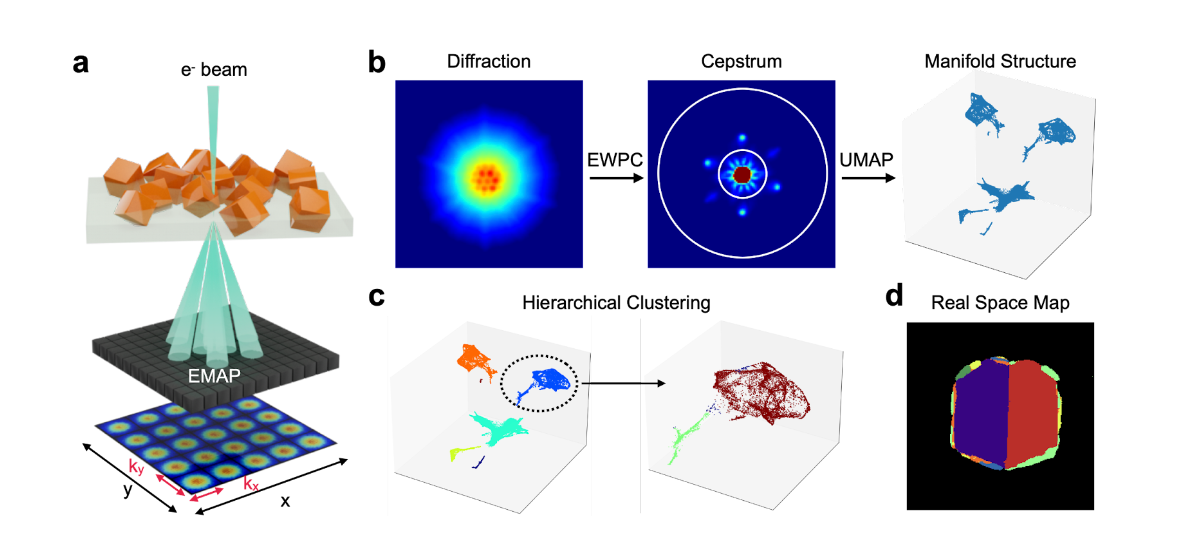About me
Hi! I am Tiancheng Yu (俞天成, pronounced as Tea-en-chung Yoo). I am an undergraduate student majoring in Physics at Peking University.
During my undergraduate, I am grateful to be advised by Prof. Peng Gao at International Center for Quantum Materials(ICQM), Peking University. Currently I am also a visiting scholar at School of Engineering and Applied Science(SEAS), Harvard University, supervised by Associate Prof. Xin Li.
My research interest includes utilizing machine learning to characterize 2D materials, electrode materials, and soft matter.
Preprints
Advancing Nanobeam 4D-STEM Through Manifold Learning in Cepstrum Space
Chuqiao Shi=, Tiancheng Yu=, Aaron Bayles, Zhihua Cheng, Matthew R. Jones, Naomi Halas, Yimo Han*. weblink

Nanobeam 4D-STEM, a potent tool for nanomaterial crystal structure analysis, faces challenges in processing large, unlabeled datasets due to noise interference. This study introduces a novel approach utilizing cepstrum transformation and manifold learning to extract vital lattice features such as strain, orientation, and domain structures. This method significantly enhances machine learning accuracy, validated across various materials like 2D ferroelectric materials and nanoparticles. The findings ensure efficient nanostructure characterization in 4D-STEM workflows.
Atomic-Scale Tracking Phase Transition Dynamics of BKT Polar Vortex-Antivortex
Ruixue Zhu=, Sizheng Zheng=, Xiaomei Li=, Tao Wang=, Congbing Tan*, Tiancheng Yu, Zhetong Liu, Xinqiang Wang, Jiangyu Li*, Jie Wang*, Peng Gao*, arXiv 2308.07583 (2023). weblink

Particle-like topologies, like vortex-antivortex (V-AV) pairs, are prominent in condensed matter research. However, detailed phase transition dynamics, including self-annihilation and motion, are often unexplored due to experimental limitations. Using polar V-AV pairs, we tracked their atomic-level transitions through advanced microscopy and simulations. We observed polarization suppression and V-AV annihilation near interfaces with increasing temperature. These findings enhance our understanding of topological phases and transitions, offering potential in electronic devices.
Experiments on Phase Transition of Faraday Waves with Xantham Gum Solutions
Peizhao Li=, Tiancheng Yu=, Xuechang Tu, Han Yan, Wei Wang, Luqun Zhou*, arXiv 2305.06690 (2023). weblink

Through experiments and neural network analysis, we explore Faraday waves in Xantham Gum Solutions (shear-thinning non-Newtonian fluid) and compare them with Newtonian fluids. We identify abrupt transitions in spatiotemporal order: onset and instability. These transitions follow power-law relationships based on driving amplitudes and frequencies. We demonstrate that the different power-law exponents during onset stem from surface tension and viscosity contributions in the surface wave dispersion relation. Additionally, we propose a theoretical model merging Navier–Stokes equations with soliton theory to explain distinct power-law exponents for instability in both Newtonian fluids and Xantham Gum Solutions.
Honors and Awards
• Outstanding Individual Performance Evaluation Oct 2023
• Lingjun Advanced Scholarship Sept 2023
• Peking University Merit Student Award Sept 2023
• Peking University Challenge Cup Excellence Prize June 2023
• China Undergraduate Physics Experiment Competition(CUPEC) Innovation Award Dec 2022
• School of Physics Weiming Scholarship June 2022 & Sept 2023
• Peking University Academic Excellence Award Sept 2021
• School of Physics Shen Keqi Scholarship Sept 2021
• Zhu Kezhen Gold Award Sept 2020
• Silver Medal in 36th Chinese Physics Olympics Final Hangzhou, China, Nov 2019
• First Prize in 36th Chinese Physics Olympics in Provinces Hangzhou, China, Sept 2019
Selected courses
Major GPA: 3.80/4.00 (equivalent to an average score of 90)
• Physics
Modern Physics 100
Theoretical Mechanics A 98
Solid State Physics A 95
Equilibrium Statistical Physics Seminar 91
Introduction of Nanophotonics and Plasmonics 98 (for graduates)
• Coding
Computational Physics A 99.5
Introduction to Computation 98
Rapid Prototyping in Innovations 98 (for graduates)
• Mathematics
Linear Algebra A 96
Advanced Mathematics A 95
• Experiments
Comprehensive Physics Experiment 93 (top 10% in General Physics Lab 1 required for enrollment)
Frontiers in Physics Experiment 90 (top 5% in Modern Physics Lab 1 required for enrollment)
(According to the policy at school of physics, no more than 40% of the class can score above 84(3.52/4.00) in any course.)
